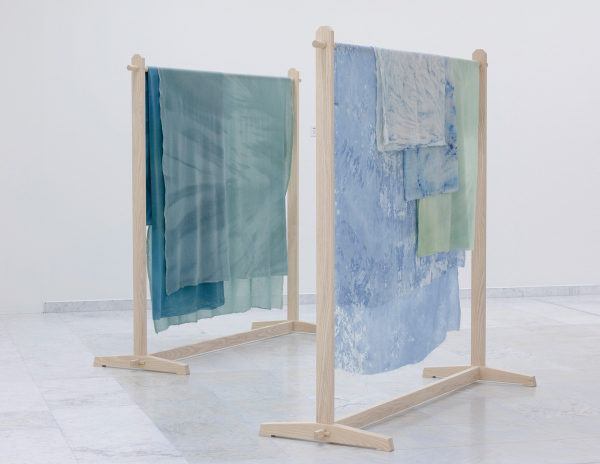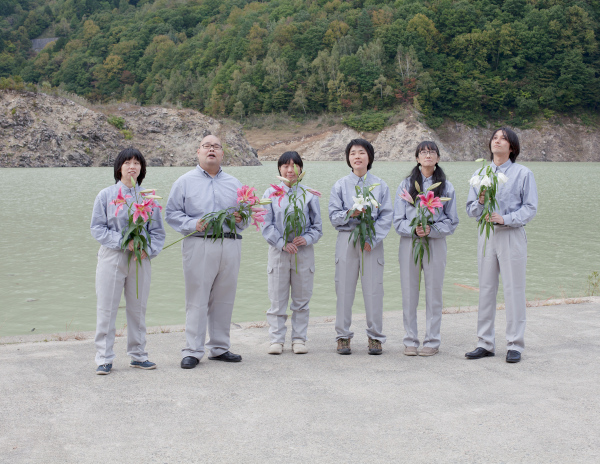A Long Hum
______________________________________________
16 mm film transferred to digital, vocal performance
in progress
|
|
Being a troubled sleeper, I enjoy watching slow films. They make me feel drowsy and on several occasions my body gave in to the desire to fall asleep. Film scholar Jean Ma argues that this is a part of spectatorship that we should value. A sleepy experience while watching a film as a respite from the constant productivity of a 24/7 capitalist society.
A Long Hum aims to capture the liminal space between waking and sleeping, using both 16 mm film and a night vision camera. Part of it was filmed with sleep researchers working with ways of monitoring sleep and dreams at the Netherlands Institute for Neuroscience.
At Bergen Kunsthall’s Live Studio, I worked with performers to make sound to the images with the voice – somewhat like the live sound in early cinema. This work is part of ongoing research around whistling with violinist and experienced whistler Hanna Kallestad.
|
|
______________________________________________
Performers at Bergen Kunsthall’s Live Studio: Hanna Kallestad, Charlotte Besuijen and Bernhard Sekkelsten.
This project was possible thanks to support from Arts Council Norway, Bergen Kommune and the Mondriaan Fund.

Hymnosphere
______________________________________________
sound, digitally woven Jacquard tapestries, wood
cotton, wool, viscose, light-reflective yarn
134 x 174 cm.
2025
|
|
The works in Hymnosphere derive from several residencies at the Ny-Ålesund Centre for Arctic Scientific Research in Svalbard. Three woven tapestries depart from laser reflectance depictions of the landscape around the research village, made in collaboration with a snow/avalanche researcher studying the changing conditions. Due to climate warming, Svalbard is experiencing an increase in rain-induced avalanches. The images of the avalanche that occurred during Serné’s stay at the research village resemble nightscapes or extraterrestrial landscapes. The similarity to stitches and threads made her want to translate these images into pixel-based patterns that can be read by a digital loom. As Sadie Plant observed in Zeros + Ones, textile images are not imposed on the surface of cloth. Instead, their patterns emerge from an active matrix that is implicit in a web, making them inherent to the processes from which they emerge. From up close, the tapestries possess a soft and fluffy appearance, along with sharp and glittering lines and dots. When viewed from a distance, the images become visible.
|
|
A hymn is a type of song or choral lyric. It originates from the Greek word hymnos, which is grounded in the semantics of fabric-making. From wall-mounted speakers, the sound of three voices can be heard humming, singing, and breathing. The soundscape evokes associations with various animals — or are they humans trying to create a new form of communication? At times, there is heavy breathing, reminiscent of the sound of deep sleep.
|
|
______________________________________________
Produced at the Textile Lab of the Textile Museum in Tilburg (NL).
Wooden frames: Anna Schmideder.
Laser scans of the landscape: Alexander Prokop.
Vocals: Hanna Kallestad, Charlotte Besuijen and Bernhard Sekkelsten.
Sound recording: Al Houthoofd.
This exhibition was supported by Arts Council Norway, Bergen Kommune and Kunstsentrene i Norge.
Documentation of the work at Galleri Christinegaard by Hugo Lütcherath.

A milky blue light/ silver seas
______________________________________________
duo show at Rogaland Kunstsenter, Stavanger
2024
These works reflect on day and night rhythms and the idea of dormancy: when organisms enter a dormant phase in response to adverse conditions. Cyanobacteria for example enter a dormant state in certain environments, they can survive in the Arctic and potentially live on Mars.
Hand-dyed textiles and screen prints made with phycocyanin (a blue light-harvesting pigment found in cyanobacteria) form a dialogue in fabric, glass and light.
Thanks to microbiologist Lara Vimercati who I met during my stay at the Ny-Ålesund Centre for Arctic Scientific Research in Svalbard.
______________________________________________
Works in the exhibition:
Second Sleep
a text for three voices, A2 poster, offset print
A conversation set in an Arctic research village that weaves together dream states with the futuristic science of cyanobacteria.
Blue Hour
screen print on paper, wooden frame (walnut)
blue pigment found in cyanobacteria, acrylic paint
80 x 53 cm
Blowing soap bubbles into the crystal-clear sky to see them freeze and pop
five hand-dyed and screen printed textiles on steel tubes
indigo, cyanotypes, phycocyanin, acrylic paint
Circadian rhythm: images of my sister taking an afternoon nap
four screen prints on glass, phycocyanin, acrylic paint
A very long bed, circadian rhythm
engraved glass, neon lights, transformers, cables
______________________________________________
Wooden frame: Matthew Coutts.
Translation: Eira Søyseth.
Proofreading English: Emma Rault.
Graphic design: Elena Op 't Eynde.
Screen printed at Trykkeriet in Bergen and the Jan van Eyck Academy in Maastricht.
Documentation: Erik Sæter Jørgensen and Ananda Serné.
This exhibition was supported by Bildende Kunstneres Hjelpefond, Billedkunstnernes Vederlagsfond and the Arts Council Norway.

Liquid Whistle
______________________________________________
solo exhibition and vocal performance at The Norwegian Sculptors Society, Oslo
2022
During one of many sleepless nights, Ananda Serné became fascinated by an article about songbirds that rehearse their melodies by singing in their sleep. To learn more about this phenomenon, Serné contacted a neurobiologist and specialist in speech development, who researches how sleep plays a central role in the learning process in songbirds. Perhaps this applies to other animals too? What about humans?
The exhibition conveys Serné's relationship to sleep and insomnia through both textile works made from her own bedsheets, a dreamlike presence of songbirds, as well as man's own "liquid whistling" as an enticing call to sleep and its magical properties. The title Liquid Whistle is inspired by a description from the book A Guide to Bird Songs, written by birdwatcher Aretas A. Saunders (1884-1970). Saunders describes one of the forms of birdsong as a "liquid whistle".
Ananda Serné works in the borderlands of the performative, digital and tactile by creating constellations of media such as video, sound, textiles and performance. In Liquid Whistle, the audience encounters such a composition, which explores the connection between sleep and the lack of it, and the songbird's whimsical practice ritual. The performative aspect of Serné's exhibitions often involves different actors, and in collaboration with these, unique experiences related to collectivity and communication are created.
Text: Emma Lomell
______________________________________________
Works in the exhibition:
Sleepsinging
A textile work made from used bed linen during a series of sleepless nights.
Zebra Finch 1
Wood (walnut), wood carving, screen printed glass. 3 pieces.
Zebra Finch 2
Archival print on aluminium.
Lynn, whistling after a sleepless night
Slide projection, 15 slides.
In an informal internet poll, 67 percent of respondents indicated that they can't whistle at all or not well. Only 13 percent considered themselves excellent whistlers.
Liquid Whistle
Graphic notation of birdsong in glass, 7 pieces.
How to Whistle
Performance with three whistlers during the opening night. Taking place in different parts of the building.
Performers: Hanna Kallestad, Anne Oven and Jo Mikkel Sjaastad Huse.
______________________________________________
Documentation: Tor S. Ulstein / KUNSTDOK and Ananda Serné.
Thanks to Formbar Glassverksted, Lynn Kasztanovics and Matthew Coutts.
This exhibition was supported by Billedkunstnernes Vederlagsfond and the Arts Council Norway.

Nachtbloeiers (a novel)
______________________________________________
novel, 224 pages
2022
Published by Uitgeverij Cossee.
The German translation Nachtblüher is published by Weissbooks.
○ Synopsis in English, by the Dutch Foundation for Literature.
______________________________________________
Genomineerd voor de Libris Literatuur Prijs en de Hebban Debuutprijs.
De een houdt een slaapdagboek bij, de ander zweert bij slaapdruppels. Slapeloosheid houdt een groot deel van de mensen bezig. Eliza woont in Noorwegen en werkt voor het Instituut voor Slapeloosheid aan een onderzoek naar de samenhang tussen insomnia en partnerkeuze. Als haar vriend hun relatie verbreekt, volgen we Eliza in een slapeloze roes door Noorwegen, Taiwan en Nederland, op zoek naar een veilige haven. Haar nachten worden korter en haar onderzoek versmelt meer en meer met haar eigen leven. In dit betoverende romandebuut brengt Ananda Serné haar lezers in een ijldroom; wat is de realiteit en waar houdt die op? Nachtbloeiers is een fascinerende meditatie over de samenhang tussen natuur en mens, tussen slaap en droom, tussen verankering en vrijheid.
De Nederlandse debutante Ananda Serné overtuigt volkomen met Nachtbloeiers, een roman die zich afspeelt in het schemergebied tussen waken en slapen. (...) In een onderkoelde verteltoon doorsnijdt Serné haar toch koortsige roman met gortdroge humor en strooit ze die vol met kennis uit de slaapwetenschap, met biologische anekdotes of met kunst- en literatuurverwijzingen.
NRC ****
Nachtbloeiers is veelomvattender en geraffineerder dan een verslag van een individuele zoektocht. Het bevat tal van nieuwsgierig makende verwijzingen naar kunst en onderzoek op het gebied van slaap, het roept allerlei vragen op. (...) Serné schrijft helder, wat goed te pas komt bij de tastende inhoud van de roman. De dialogen zijn sterk. De roman is bovendien geestig en spannend.
Femke Brockhus op De Reactor
Het is knap hoe in dit verhaal trauma als een fijnzinnige kracht wordt ingezet, die zo nu en dan voelbaar is maar niet nadrukkelijk uitgesproken wordt – waardoor het nergens pathetisch aandoet. In slaap vallen is een vorm van overgave, net als het verwerken van iets waar je liever niet aan denkt. Dat werkt ook door in de roman, die ondanks zijn registrerende stijl iets ongrijpbaars heeft, een welkome zweem van mysterie.
Serné schrijft zeer geloofwaardig, nergens overdadig. Wat opvalt is daarbij hoe naturel ze dialoog schrijft. De beelden en metaforen die ze gebruikt, zijn het geraamte van het verhaal, maar zonder te nadrukkelijk aanwezig te zijn.
Een roman die het particuliere van een slecht slapende jonge vrouw helemaal overstijgt. Het is een verkenning van de slaapwereld via kunst en literatuur en architectuur. Tegelijk is het een kritiek op het jachtige leven waarvan we collectief het slachtoffer worden, en waaraan we ons zo verdraaid moeilijk kunnen onttrekken.
Door de serene, haast zakelijke stijl van schrijven voelt die kritiek niet eens als kritiek aan. Het lijkt meer op het zachtjes fileren van een systeem dat ons allen richting slapeloosheid en uiteindelijk de sluimerklinieken drijft.
Edith Vroon van Linnaeus Boekhandel in Mezza AD
Ik lig vaak lang wakker. Als ik dan een roman als deze kan lezen, verlang ik er bijna naar. Een prachtig debuut.
RTV Lansingerland
Nachtbloeiers is een zeer geslaagd debuut. Hopelijk horen we meer van deze schrijfster.
Nachtbloeiers in Brommer op zee, VPRO.
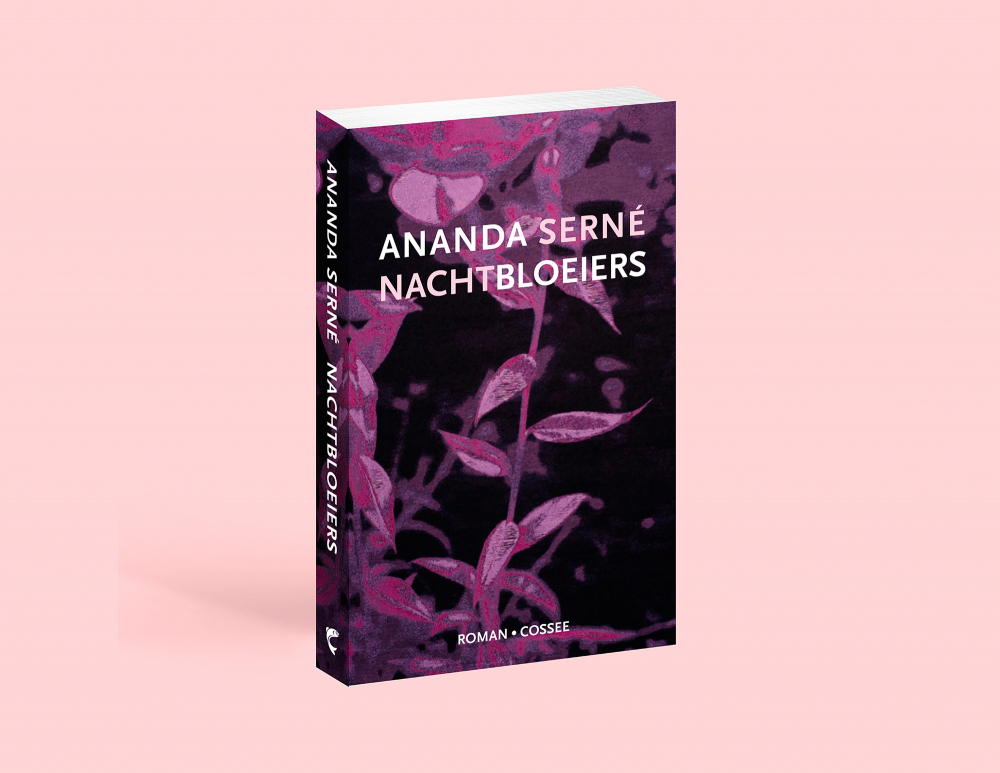
Insect sing-along
______________________________________________
solo exhibition and vocal performance at puntWG, Amsterdam
4K video with sound, offset printed text, neon lights,
performance with a choir at sunset
2022
|
|
The clap of a butterfly’s wings and the buzzing sounds of sudden movement of an imperceptible brown moth. Eyes closed, these sounds are an intoxicating hum; drawn to the night like a lullaby.
Insect sing-along follows the lifecycle of a butterfly: caterpillar, cocoon, to the final metamorphosis towards adult form. Insects are often our closest animal neighbours, and yet, are overlooked in ecological terms. The final form of the butterfly suddenly morphs into a robotic insect developed at the Delft University of Technology. These prototypes could potentially help with the pollination tasks of dwindling insect populations. The surprising history of lepidopterans and technology stems from a remarkable anecdote of the original “computer bug” - a squashed moth that affected early computer operations in 1947.
Behind the screen, a neon blue glow draws the audience upstairs to a sculptural light work. Moths have a strange fascination for artificial sources of light. It is thought that they fly at a constant angle to the light of the moon in order to navigate. They often mistake artificial light for moonlight and in this way lamps distract them and they seem to forget about everything else.
At sunset and nightfall, Serné presented a performance in the garden developed together with the vocal ensemble Genetic Choir. During regular exhibition hours, a sound piece developed and recorded with choir member Miyuki Inoue accompanied the silent film.
- Text by Àngels Miralda
|
|
______________________________________________
Concept, filming and editing: Ananda Serné
Animation: Poyen Wang
Robot insect: Matěj Karásek / Flapper Drones at Delft University of Technology
Voice video: Miyuki Inoue
Sound recording: Marcel de Rooij / De Slapende Hond
Graphic design poster: Elena Op 't Eynde
Performance with singers from vocal ensemble Genetic Choir during the opening at puntWG:
Yankı Bıçakçı, Jeannette Huizinga, Miyuki Inoue, Lily van Leeuwen, Moira Mirck, Ilyas Nadjafi, Susanne Ohmann and Marjolijn Roeleveld
|
|
The solo exhibition Insect sing-along at puntWG in Amsterdam came to exist in conversation with curator Àngels Miralda.
Documentation: Ilya Rabinovich and Gert Jan van Rooij

Siren's Song
______________________________________________
neon lights, transformers, cables
2022
Nocturnal insects have a strange fascination for artificial sources of light. It is thought that they fly at a constant angle to the light of the moon in order to navigate. These insects often mistake artificial light for moonlight and in this way lamps distract them and they seem to forget about everything else.

Pellicule
______________________________________________
installation activated through performance
Tou, Stavanger, 2023
glass, wood, costumes, overhead projectors, transparant sheets, video, sound
performance duration: 30 min.
While at night many of us are asleep, moths circle around street lights in the darkness outside. By employing robotic flowers, labs are investigating how well moths can see in the dark. The part of the brain that processes visual information slows down at night, allowing the moth's compound eyes to pick up more light, comparable to the long shutter speed of a camera. This will make the photographs brighter, but the slower the shutter speed, the harder it is to get the subject in focus.
The French word "pellicule" refers to a fine membrane that encases parts of plant or animal organisms. "Pellicule" also refers to the analog film used in photography, the thin light-sensitive layer that is to receive the impression.
______________________________________________
Collaboration with visual artist Helene Espedal-Selvåg, dancer Marie Ronold Mathisen and musician John Derek Bishop.
Documentation: Ananda Serné.
This project was supported by Tou, Stavanger Kommune, Billedkunstnernes Vederlagsfond and Arts Council Norway.

slow-wave
______________________________________________
4-channel sound installation
glass, hand-dyed and painted textiles, aluminium
indigo, cyanotype, phycocyanin
2021
|
|
|
In the installation slow-wave, different voices mimic the sound of water and pronounce water onomatopoeia such as: bloop, splish, splash, sprinkle, drip, drup, drizzle, dryss, drypp and spray. "Slow-wave sleep" is the deepest phase of non-rapid eye movement sleep.
The colours of the textiles derive from cyanotype, indigo and a blue light-harvesting pigment found in cyanobacteria. The cyanobacteria is the simplest organism currently known to have a day and night rhythm.
|
|
|
______________________________________________
|
|
Documentation of the work at Bryne Kunstforening: Erik Sæter Jørgensen.
|
|
Listen to the audio:

Night-scented Flowers
______________________________________________
infrared photographs translated into digitally woven Jacquard tapestries
wool, cotton, light-reflective yarn, 190 x 147 cm.
2019
|
|
Moths have a strong fascination for artificial sources of light. They are less active, feed less, and pollinate fewer flowers when drawn to light at night. Lamps can distract them to the extent that they forget about everything else, perhaps similar to the way in which humans are drawn to screens.
At night, I made infrared photographs of several night-blooming plants that moths feed on. With the help of a computerised Jacquard loom, I then translated these infrared photographs of nocturnally blooming flowers into woven tapestry. The photographs were downloaded into a software program that translated each colour into a combination of threads.
The tapestries refer to the moth that got stuck inside the machine that computer pioneer Grace Hopper and her team worked on in 1947, this moth has been described as the first software bug.
______________________________________________
Produced at the Textile Lab of the Textile Museum in Tilburg (NL).
Documentation of the work at Fotogalleriet in Oslo by Jan Khür, and at the Jan van Eyck Academy by Romy Finke.

Duet/ Songs
______________________________________________
text on transparent sheets, hand-dyed textiles, reading by two vocalists
2020
|
|
Duet/ Songs consists of words that imitate sounds based on machine-generated transcripts of insect communication. The text derived from sound recordings of insect calls by entomologist Liao Yi-Chang, these recordings were inserted into transcription software originally meant to transcribe human speech.
Throughout 2019/20, I gathered auditory and visual impressions of the ways in which insects navigate man-made environments. I focused on their movements and their sense of hearing; the sounds they produce in order to communicate. During this process, I got to know biologist Liao Yi-Chang who is specialised in insect communication and I was introduced to his personal archive of insect recordings. Among the recorded sounds were calls of plant lice that without amplification would be inaudible to the human ear. I fed some of these recordings to transcription software meant to transcribe human speech. The insect recordings translated to onomatopoeic renditions such as:
Psst, psst, psst, psst, psst, psst, psst, psst, psst, psst, psst, psst, psst, psst, psst, psst.
and,
LOOK LOOK LOOK LOOK LOOK LOOK LOOK LOOK LOOK LOOK LOOK LOOK LOOK LOOK LOOK LOOK LOOK LOOK LOOK LOOK LOOK LOOK LOOK AT THE PEOPLE.
______________________________________________
This text resembling sound poetry was performed at gallery Titanik in Turku (FI) by classical vocalists Pietari Skyttä and Katriina Virta.
The onomatopoeic translations were furthermore gathered in the publication Duet/ Songs by publisher In the End Books.
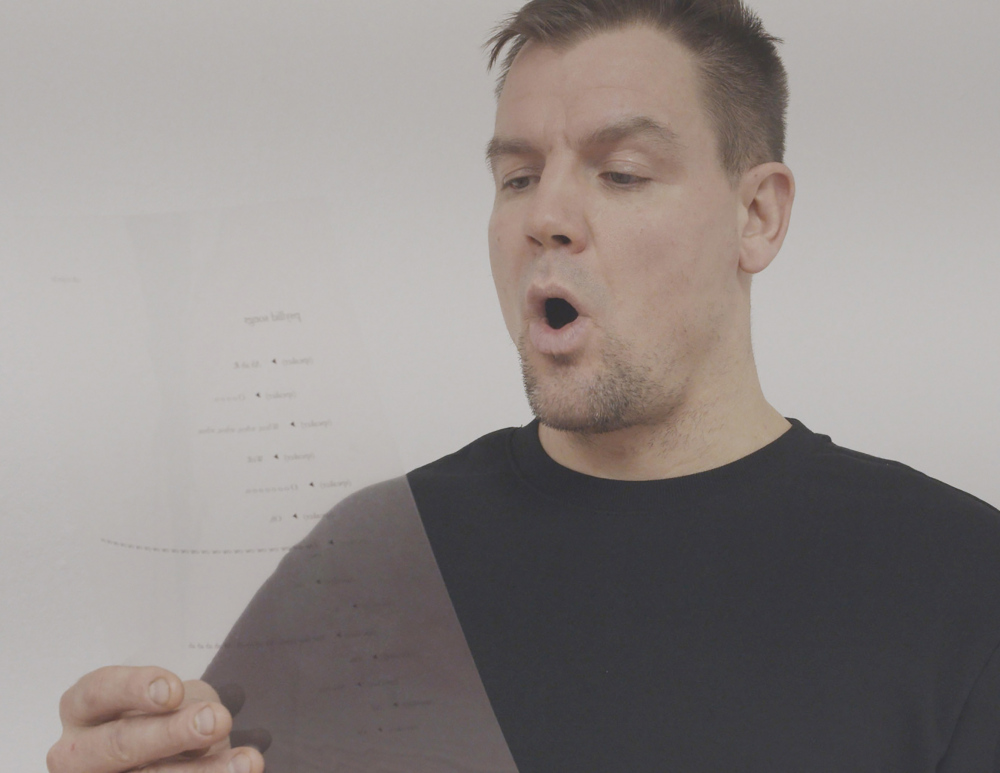
Opera
______________________________________________
4K video with sound
2021
An opera singer is doing vocal exercises in the darkness of a former iron ore mine. The word opera is borrowed from Italian and means work, both in the sense of the labour done and as a result produced.
Opera was part of the site-specific collaborative project Book of Sand / Singular Hands with artists Matt Bryans and Håvard Sagen and sociologist Merete Jonvik. Together we explored the dormant mythologies of three artist-run spaces in Rogaland, Norway. These places were situated in a post-mining landscape, a marketplace, and agricultural surroundings.
______________________________________________
Soprano: Bodil Arnesen

A caterpillar is curled in a green ring
______________________________________________
4K video, sound, 12:02 min.
2019
The repetition and rhythm of insects’ sounds can be perceived as machine-like. Shot in and around Taipei, the video A caterpillar is curled in a green ring unfolds in a series of visual and auditory impressions of insects in a man-made environment. It includes a choreography of insect names in Taiwanese sign language.
These images are set to a soundtrack partly consisting of recordings made by an entomologist who collected insect sounds that without amplification would be inaudible to the human ear.
______________________________________________
Directing, filming and editing: Ananda Serné
Actress/sign language teacher: Chen Li-Juan
Sign language interpreter: Wei Ru-Jun
Audio mastering: Sveinbjörn Thorarensen
Many thanks to the team of Bamboo Curtain Studio for their help and to entomologist Liao Yi-Chang for his insect recordings.
This project was possible thanks to the Mondriaan Fonds and Stichting Gerbrandy Cultuurfonds.
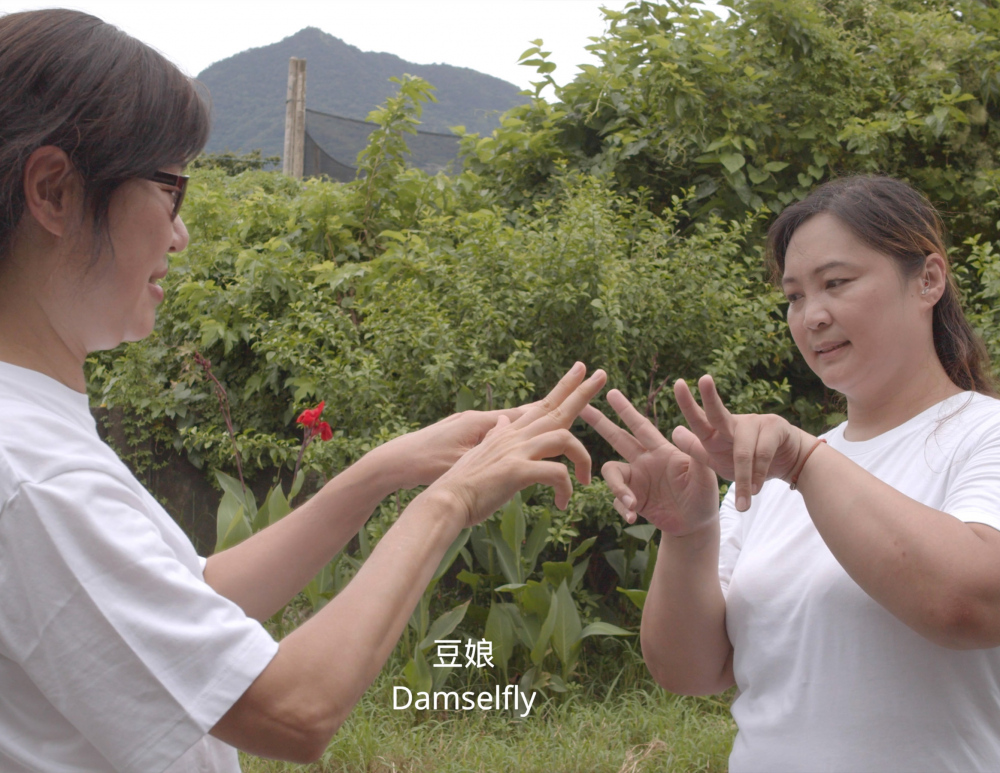
Sleeptalking
______________________________________________
audio/textile installation
2020
|
|
Sleeptalking brings together a recording of a vocalist rehearsing a lullaby and a set of textiles on wooden frames. The vocalist doesn’t fully remember the lyrics of the lullaby and stumbles on her words. By translating the lullaby into a song that should be practiced, the soothing qualities inherent in lullabies transform into something else. The colours of the textiles derived from cyanotype, indigo and a blue light-gathering pigment found in cyanobacteria.
The cyanobacteria is the simplest organism currently known to have a day and night rhythm.
______________________________________________
Woodwork: Matthew Coutts
Vocals: Signe Irene Time
Thanks to chronobiologist Shona Wood from UiT The Arctic University of Norway for telling me about the circadian rhythms of tiny organisms.
Documentation of the work at Stavanger Art Museum: Oddbjørn Erland Aarstad
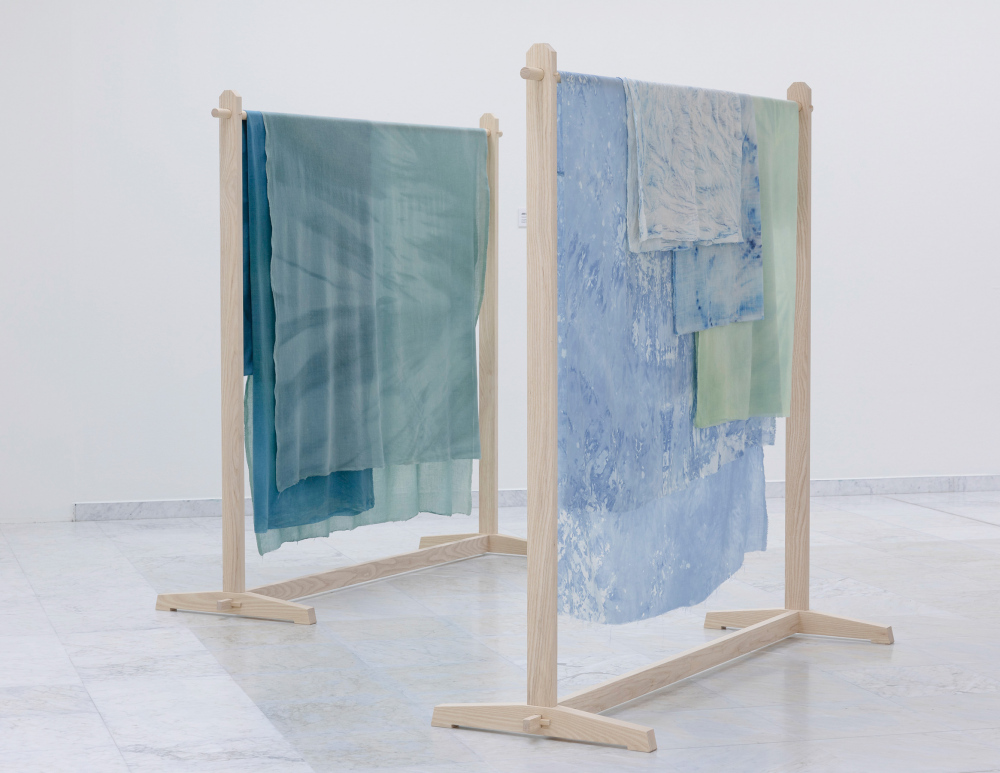
Echoists of the Takase River
______________________________________________
HD video, sound, 03:16 min
publication, offset printing
594 x 420 mm, edition of 250
2017
In science, the word sounding means: 'to study the underwater depth of lake or ocean floors by transmitting sound pulses into water'. Data taken from soundings are used to map the seafloor, an area that is still largely unknown to human beings. According to the Merriam-Webster dictionary sounding can also mean: a probe, a test, or sampling of opinion or intention. Like a bat exploring its surroundings by sending out a signal and listening to the echo in order to find out what’s there.
During a three-month residency in Japan, I explored the meaning of the word sounding and drew a parallel with the Japanese word kodama. Kodama can be translated into English as echo, but is in Japanese folklore also known as a phenomenon that reverberates sounds in mountains and valleys. Spoken words reflected against the landscape are thought to be kodama, trees that are answering.
Late in the 1970s, three dams were built along the course of the Takase river in Nagano Prefecture. Echoists of the Takase River focuses on the vegetation around one of these dams. A Japanese sign language interpreter signs the word kodama/ echo, while a group of performers shout both the names of plants and trees that died during the construction of the dam, as well as the names of pioneer species that were the first to colonise the previously disrupted land.
______________________________________________
Directing, filming and editing: Ananda Serné
Performed by: Naoto Nakamura, Mariko Nishijo, Mio Nishitani, Chihiro Takahashi, Tomoaki Urano and Akemi Watanabe
Sign language interpreter: Atsuko Tanabe
Sound design: Sveinbjörn Thorarensen
Translation: Sosei Sato
This project was possible thanks to the team of Asahi AiR and the generous support of the city of Ōmachi, Nagano, Japan.













